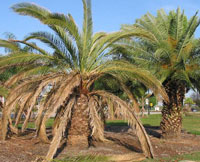About this tool
Introduction

Symptoms of Diseases and Disorders, one of four tools comprising a commodity-based resource for pests and diseases of cultivated palms, is designed to help users make a preliminary field diagnosis of a palm problem. Since many diseases, disorders, and insect pests can cause similar symptoms, this tool will often lead to more than one possible field diagnosis. Consulting the fact sheets may help to narrow down the diagnosis to a single cause. For definitive confirmation of diseases and insects, the appropriate tissue samples or insect specimens should be sent to an expert for verification.
This tool was originally released in December 2010. The tool's key was updated in April 2018 from a key server version to a Javascript version to increase usability; in particular, the Javascript key offers an improved image viewer. In October 2014, the tool was updated to make the site dynamic, bringing the fact sheet data into ITP's online database and allowing the creation of a filterable image gallery. However, there were no content updates to the key or fact sheets as part of either update, so all the fact sheet and key content is current as of December 2010.
This tool is based solely on visual symptoms for two primary reasons. First, visual symptoms are sufficient to diagnose many palm problems, especially physiological disorders such as nutrient deficiencies. Second, visual symptoms are the first step in determining which diagnostic lab to use for further analysis and which tissue should be sampled for analysis. Many times, diagnosis of a palm problem is a multi-step procedure whereby possible causes of the problem are ruled out, one at a time. Never rely on a laboratory diagnosis without also making a good faith attempt at the visual diagnosis. The two diagnoses should agree. Just because a laboratory report suggests deficiencies of one or more nutrient elements or the presence of one or more potential pathogens does not mean that those deficiencies or pathogens are the actual cause of the particular problem. “False positives” are common, and often misleading. This is one weakness of laboratory diagnostics when used as the sole method of diagnosis. In the case of palm diseases, “false negatives” are also a common problem, especially when the wrong tissue is sampled or a sample of poor quality is submitted to the laboratory. If the two diagnoses (visual and lab) do not agree, then re-examine the problem to determine which diagnosis is more likely to explain the symptoms being observed (compare to descriptions and photos in the fact sheets), and if you sampled the correct material for the laboratory diagnosis. Alternatively, you may need to start at the beginning as neither diagnosis may be correct.

The intended audience for this tool is non-experts working in the field within Cooperative Agriculture Pest Survey (CAPS), National Plant Diagnostic Network (NPDN), and other national, regional, and state agricultural agencies/organizations with responsibilities associated with pest and disease survey and detection. However, the tool will be useful for anyone who manages palms in a nursery or landscape setting. All features in the key can be used with the naked eye or a hand lens. Since palms are monocot trees, with a different anatomy from hardwood trees, a glossary is provided with links from the fact sheets and a diagram of palm anatomy to help the user understand terms used in this tool.


